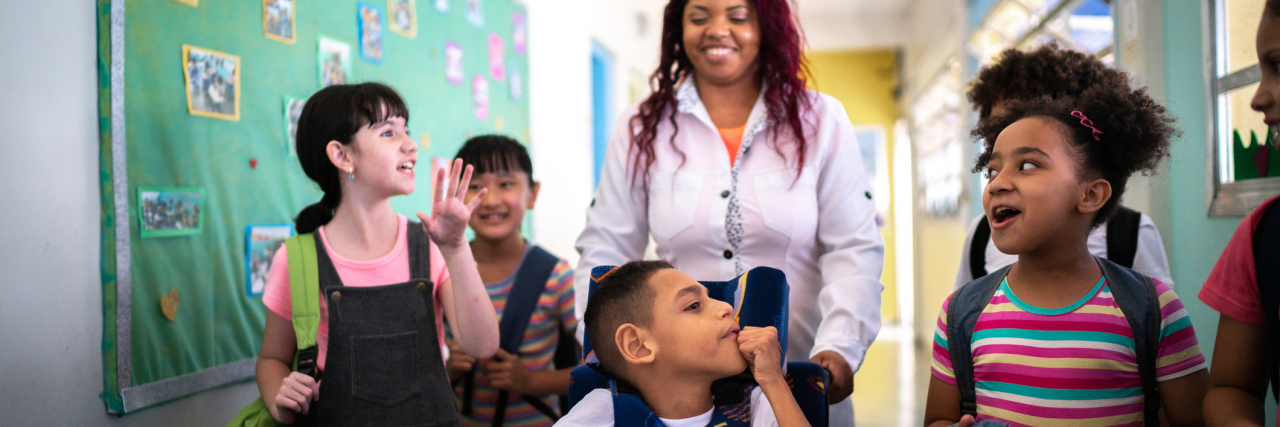Is Inclusion Optional? Nope. Not Optional. It’s the Law.
Was inclusion discussed at your student’s last IEP meeting?
Maybe it was mentioned, but you were told it wasn’t an option because of your student’s needs (can’t keep up with curriculum, challenging behavior, non-verbal, not toilet-trained)?
Perhaps your school said they don’t have the resources to offer inclusion because they are a (rural/urban/suburban/big/small) district?
Are these legal reasons for sending a student out of district or into a “special” class?
Here is my summary of the law and some suggestions.
The Individuals with Disabilities Education Act (IDEA) requires that states provide students with disabilities a Free Appropriate Public Education (FAPE) in the Least Restrictive Environment (LRE). This is federal law and all public schools (regardless of size or location) must follow it.
IDEA creates a legal presumption in favor of inclusion.
Just like a criminal defendant is presumed innocent; a student with a disability is presumed included.
Federal Regulations state that: “[u]nless the IEP of a child with a disability requires some other arrangement, the child is educated in the school that he or she would attend if nondisabled….” 34 CFR § 300.116 (c)(emphasis added).
According to the United States Supreme Court, schools must educate students with disabilities in general education “whenever possible.” Although courts use slightly different tests for deciding whether a school has followed the law, every court recognizes inclusion as the legally preferred placement.
In other words, as a matter of law, every IEP meeting must begin with a discussion and decision about whether the student can, with the use of supplementary aids and services, be appropriately educated in the class (and at the school) she would attend if she did not have a disability.
To be clear, the question is not “can the student be successful in general education”? The question is “can the student be successful in general education with the use of supplementary aids and services?”
What are “supplementary aids and services” that can be provided to students with disabilities in general education? Here’s an extensive sample checklist from Dr. Julie Causton of Inclusive Schooling.
In sum, the placement conversation must start with the presumption that the student can be supported in general education. We consider removal and special classes only when/if it has been determined that the student cannot make progress toward the IEP goals even with all of the supplementary aids and services they could be provided in general education.
Some practical advocacy tips:
1. Remember Roncker.
The majority of courts follow the “Roncker Portability Test,” which says that if a supplementary aid or service can be provided in general education, it must be provided there. In other words, supports and services go to students, not students to supports and services. If the school says the student needs a more restrictive placement, ask why the supports and services offered there can’t be provided in general education.
2. Classmates Count.
If the school thinks the student would benefit from some part(s) of the “special” class or program (such as a smaller class size or more specialized instruction), be sure to point out the importance of typical peers. Even if there might be some benefit from a smaller class size, our student is losing the many benefits of learning alongside age-appropriate communication and behavior models (and missing out on the chance to form friendships and gain allies among those students). Schools are legally required to consider the well-established, significant social benefits of inclusion when making placement decisions.
3. A Need for Modification Isn’t a Reason for Removal.
Do not accept the argument that inclusion is not appropriate because the student needs to “keep up” with the general education curriculum. A special education teacher can work with the general education teacher to provide a modified, prioritized lesson that gives the student access to the curriculum at her pace and level. The measure of progress is the IEP goals, not the general education curriculum.
4. A 1:1 Paraprofessional is a Support, Not A Setting.
Sometimes, families are told that general education with a 1:1 paraprofessional (teaching assistant or teacher’s aide) is a “restrictive” setting. This mistakes a person for a place. A paraprofessional is a support provided to a student; not an educational setting. If we are worried about a paraprofessional “over-supporting” the student, that’s a challenge to be solved with professional development about how to fade support in inclusive settings, not an excuse for exclusion.
5. It’s Not All or Nothing.
Inclusion can be more of a journey than a destination. In any individual situation, full inclusion might be the legally proper placement, but not what you decide is in your student’s best interest. That’s a decision each family needs to make with the rest of us giving grace and respect. However, if you have decided that full inclusion isn’t the choice for your student, you might still push for “mainstreaming” opportunities — for specials, recess, lunch, and/or extracurriculars. Students placed in special classes for academics are still legally entitled to be included in activities with their typical peers “to the maximum extent appropriate.”
Getty image by FG Trade

